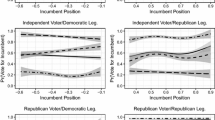Abstract
This paper presents a spatial model of primary election to analyze strategic voting and its effect on the policy outcome. Primary voters care for the electability of the candidates as well as their offered policies. The trade off between these two factors might make the preferences of the primary voters non-single-peaked. I show the median voter is still decisive when the preferences are quadratic. Moreover, I use comparative statics and numerical analysis to evaluate the conditions under which the position of the Condorcet winner in the primary election shifts toward the center. Among the conditions that contribute to such a shift are radical policies by the incumbent, public opinion shift toward the incumbent party, and accurate information about the population median.



Similar content being viewed by others
Explore related subjects
Discover the latest articles and news from researchers in related subjects, suggested using machine learning.Notes
26 % of the Democrats in the Iowa entrance poll stated that the most important quality of the candidate for them is whether he “can beat Bush”. That number in the New Hampshire exit poll was 20 %.
for a deep discussion of strategic voting see Buchanan and Yoon (2006).
For an alternative analysis see Banks and Kiewiet (1989).
More on this can be found at McCartey et al. (2006).
Alternatively Aranson and Ordeshook (1972) has more focus on candidate’s strategic choice of policy.
That is the main difference between my model and Adams and Merrill (2008) too, as they assume primary voters vote sincerely.
This specification is general enough to include many known distribution functions like normal distribution and uniform distribution.
It could potentially affect some results in Sect. 5, depending on the way that party formation is modeled.
Technique is similar to Banks and Duggan (2006).
Those two are the most commonly used necessary conditions for application of the median voter theorem.
The main difficulty is the lack of analytical form for the cumulative distribution function.
According to Banks and Kiewiet (1989) during 70’s and 80’s “over 93% of Incumbent members of congress who seek reelection have been successful”.
At \(z=-\epsilon \) the two candidates have equal chance of winning the general election. But for any small enough \(\delta \), (\(\delta > 0\)), the challenger wins for sure.
References
Abramowitz AI (1989) Viability, electability, and candidate choice in a presidential primary election: a test of competing models. J Polit 51(4):977–992
Abramson PR, Aldrich JH, Paolino P, Rohde DW (1992) Sophisticated voting in the 1988 presidential primaries. Am Polit Sci Rev 86:55–69
Adams J, Merrill S (2008) Candidate and party strategies in two-stage elections beginning with a primary. Am J Polit Sci 52(2):344–359
Aldrich JH (1980) Before the convention: strategies and choices in presidential nominating campaigns. University of Chicago Press, Chicago
Aranson P, Ordeshook P (1972) Spatial strategy for sequential elections. In: Neimi RG, Weisberg F (eds) Probability models of collective decision making. Charles E. Merrill, Columbus, Ohio, pp 298–331
Banks J, Duggan J (2006) A social choice lemma on voting over lotteries with applications to a class of dynamic games. Soc Choice Welf 26:285–304
Banks JS, Kiewiet DR (1989) Explaining patterns of candidate competition in congressional elections. Am J Polit Sci 33:997–1015
Bartels LM (1988) Presidential primaries and the dynamics of the public chice. Princeton University Press, Princeton
Blumkin T, Grossmann V (2009) May increased partisanship lead to convergence of parties policy platforms? Public Choice 145:547–569
Bruter M, Erikson RS, Strauss AB (2009) Uncertain candidates, valence, and the dynamics of candidate position-taking. Public Choice 144:153–168
Buchanan JM, Yoon YJ (2006) All voting is strategic. Public Choice 129:1599–1607
Burden BC, Jones PE (2006) Strategic voting in the united states. Mimeo, Harvard University, Department of Government, Cambridge
Calvert R (1985) Robustness of the multidimensional voting model: candidate motivations, uncertainty, and convergence. Am J Polit Sci 29:69–95
Coleman J (1971) Internal processes of political parties in elections. Public Choice 11:35–60
Coleman J (1972) The positions of political parties in election. In: Neimi RG, Weisberg F (eds) Probability models of collective decision making. Charles E. Merrill, Columbus, Ohio, pp 332–357
Downs A (1957) An economy theory of democracy. Harper and Row, New York
Glaeser EL, Ponzetto GAM, Shapiro JM (2005) Strategic extremism: why republicans and democrats divide on religious values. Q J Econ 120:1283–1330
Groseclose T (2001) A model of candidate location when one candidate has a valence advantage. Am J Polit Sci 45(4):862–886
Hummel P (2010) Flip-flopping from primaries to general elections. J Public Econ 94:1020–1027
Jackson MO, Mathevet L, Mattes K (2007) Nomination process and policy outcomes. Q J Polit Sci 2:67–92
Kenney PJ, Rice TW (1992) A model of nomination preferences. Am Polit Q 20:267–286
McCartey N, Poole KT, Rosenthal H (2006) Polarized America. MIT Press, Cambridge
Meirowitz A (2005) Informational party primaries and strategic ambiguity. J Theor Polit 17:107–136
Monardi FM (1984) Primary voters as retrospective voters. Am Polit Q 22:88–103
Nownes AJ (1992) Primaries, general elections, and voter turnout: a multinomial logit model of the decision to vote. Am Polit Q 20:205–226
Owen G, Grofman B (2006) Two stage electoral competition in two-party contests: persistent divergence of party positions. Soc Choice Welf 26:547–569
Snyder J, James M, Ting MM (2011) Electoral selection with parties and primaries. Am J Polit Sci 55:782–796
Southwell PL (1989) Strategic voting in the 1984 democratic presidential primaries. Soc Sci J 26:445–453
Southwell PL (1991) Open versus closed primaries: the effect on strategic voting and candidate fortunes. Soc Sci Q 72:789–796
Stone WJ (1982) Party, ideology, and the lure of victory: Iowa activists in the 1980 prenomination campaign. West Polit Q 35:527–538
Wittman D (1983) Candidate motivation: a synthesis of alternative theories. Am Polit Sci Rev 77:142–157
Author information
Authors and Affiliations
Corresponding author
Rights and permissions
About this article
Cite this article
Mirhosseini, M.R. Primaries with strategic voters: trading off electability and ideology. Soc Choice Welf 44, 457–471 (2015). https://doi.org/10.1007/s00355-014-0845-4
Received:
Accepted:
Published:
Issue Date:
DOI: https://doi.org/10.1007/s00355-014-0845-4




